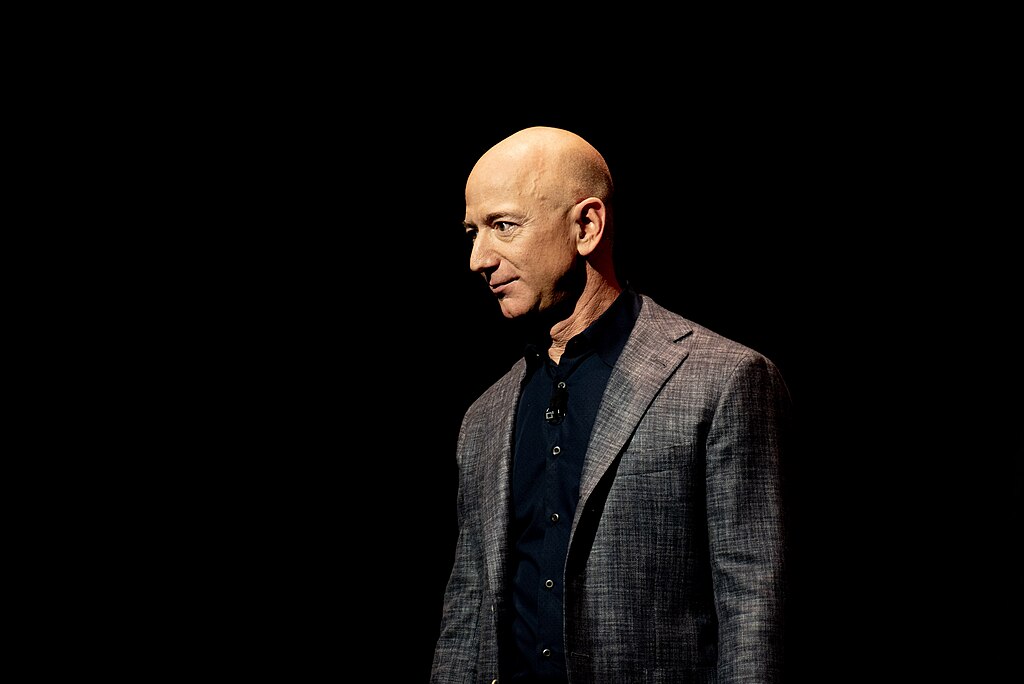Jeff Bezos Surprises Executives by Calling Amazon Customer Service During a Meeting and Teaches a Powerful Lesson on Leadership

Sometimes, truth doesn’t reveal itself through data. It shows up in the silences in the moments when everyone in the room looks at each other, unsure what to say. That’s exactly what happened when Jeff Bezos, founder of Amazon, picked up the phone during a meeting and called his own company’s customer service line.

It wasn’t a publicity stunt. It wasn’t to embarrass anyone. It was about integrity. It was about truth. And it was about remembering that the customer is not a number, but a person.
The Moment That Stopped the Room
During one of Amazon’s executive meetings, Jeff Bezos noticed a troubling inconsistency between what his leadership team reported and what customers were actually experiencing. Several senior staff members assured him that customers could reach an Amazon representative within sixty seconds. On paper, the data confirmed it. But Bezos, who had built his company around the principle of customer obsession, had already seen numerous complaints indicating otherwise. He knew something wasn’t adding up.
Bezos decided to test the claim in real time. Without warning, he picked up the phone and called Amazon’s customer service line in front of his executives. “I have a saying which is: when the data and the anecdotes disagree, the anecdotes are usually right,” Bezos explained later on the Lex Fridman Podcast, December 2023. “It doesn’t mean you just slavishly follow the anecdotes then, it means you go examine the data.”
As the phone rang, the room fell completely silent. Executives who had moments earlier spoken with confidence now shifted uncomfortably in their seats. Bezos and the team waited. One minute passed, then two, then five. No one spoke. The sound of the ticking clock became its own lesson in accountability. After ten minutes, the call was finally answered. By then, Bezos didn’t need to say a word. The room had absorbed the point: the data they trusted had been painting an incomplete picture.
That simple yet powerful act demonstrated what leadership through truth looks like. Bezos wasn’t trying to expose or shame anyone. He was teaching that data should serve reality, not define it. The exercise highlighted how easily organizations can lose touch with the lived experiences of their customers when they focus too narrowly on metrics instead of meaning. By letting silence and evidence do the talking, Bezos turned a ten-minute phone call into a transformative moment of self-awareness for everyone in the room.
When Data Lies and Truth Waits on the Line
Numbers can be comforting because they appear objective and precise, yet Bezos’ story shows how data can conceal deeper truths when not examined carefully. After that meeting, he realized that Amazon’s customer service data wasn’t entirely wrong in its calculations but flawed in what it chose to measure. “It dramatically made my point that something was wrong with the data collection. That set off a whole chain of events where we started measuring it right,” he said on the Lex Fridman Podcast, December 2023.

The issue wasn’t just about metrics; it was about meaning. Amazon had been tracking averages and response times, but not the actual customer journey from frustration to resolution. The company learned that what seems efficient on paper can still fail real people. This revelation led Bezos to emphasize that data should reflect experience, not replace it. In doing so, he pushed Amazon toward metrics that represented customer trust, not just speed or volume.
This shift carries a lesson far beyond corporate settings. We all use numbers, financial goals, social media stats, productivity targets, to define success, yet they rarely show the full story. Bezos’ approach reminds us that growth without empathy is shallow, and data without context can distort reality. To truly measure progress, we must look beyond what is easy to count and focus on what actually counts.
Truth Telling as a Leadership Principle
Bezos called the experience “an example of truth telling.” He said, “That is an uncomfortable thing to do but you have to seek the truth even when it is uncomfortable,” in his conversation on the Business Insider summary of the Lex Fridman Podcast. This simple reflection captures the core of his leadership: courage guided by honesty.

To Bezos, leadership is not about authority but about transparency. He showed that truth telling is a discipline that strengthens trust and prevents complacency. When leaders choose honesty over comfort, they build organizations that can grow with clarity and purpose.
This principle applies to more than business. Whether in teams or personal relationships, truth telling invites accountability and fosters genuine connection. Bezos’ calm response in that meeting proved that integrity often speaks loudest in silence. He reminded everyone that progress begins when we stop defending appearances and start seeking understanding.
The Chair for the Customer
One of Jeff Bezos’ most memorable leadership symbols was the empty chair he placed in every meeting. The chair represented the customer, the silent presence that guided every discussion. It was not a gimmick but a reminder that Amazon’s decisions must always center on the people who rely on its services.
The power of this gesture lies in its simplicity. By giving the customer a figurative seat at the table, Bezos turned empathy into a corporate principle. The empty chair was a visual cue that pushed leaders to think beyond spreadsheets, projections, or quarterly gains. Every conversation had to answer one question: How does this serve the person we exist to help?

This mindset helped shape Amazon’s culture of customer obsession. It cultivated a habit of listening rather than assuming, responding rather than reacting. More importantly, it taught employees that leadership requires accountability to those who are not in the room but are most affected by the decisions made there.
Beyond Amazon, the lesson is universal. Whether in business, education, or personal life, placing that “empty chair” in our own conversations means remembering empathy before action. It reminds us to include the unseen voices, the ones who depend on our honesty, fairness, and effort, in the decisions we make every day.
What We Can Learn from This
Jeff Bezos’ simple yet bold decision to call Amazon’s customer service line revealed something deeper about leadership. It was a reminder that effective leadership is rooted in humility and the courage to verify the truth for oneself. Rather than relying on filtered reports or polished presentations, Bezos chose to see reality through the eyes of the customer. That willingness to step into the experience of others turned an ordinary meeting into a transformative lesson.
The story teaches that accountability begins with curiosity. By testing the assumptions of his own team, Bezos showed that growth requires a readiness to question what feels certain. He proved that progress is born not from comfort but from the ability to face discomfort with honesty and intent. This was not about catching mistakes; it was about creating a culture where truth could thrive.

For anyone in a position of influence, the lesson is both personal and practical. Whether leading a team, building a business, or managing one’s own life, growth depends on the ability to stay connected to the human experience behind every decision. Bezos’ call was a powerful example of this principle in action. It reminded everyone that the best decisions are made when we listen first, measure second, and always keep integrity at the center.
The Power of Silence and Self Reflection
Silence is often uncomfortable, yet it holds extraordinary power. In that meeting, the quiet that filled the room became a teacher. It stripped away defensiveness, revealing the truth that numbers and words alone could not. For Jeff Bezos and his team, that pause turned into a mirror reflecting the gap between their perception and the customer’s reality. It showed that true awareness often arrives when we stop talking and start listening.
In leadership and in life, silence allows space for reflection. It helps us notice what we overlook in our rush to act or to explain. Bezos’ use of silence transformed a tense moment into a lesson in patience and presence. It reminded his team that real progress often starts not with immediate answers but with observation and humility.
The lesson extends beyond the boardroom. In our personal lives, silence helps us connect more deeply with ourselves, with others, and with truth. It gives us the clarity to distinguish what is urgent from what is important. By embracing stillness, we gain the courage to face reality without distortion. As Bezos’ story shows, silence is not emptiness; it is awareness waiting to be heard.
Key Insights on Leadership, Truth, and Self Awareness
At its heart, Jeff Bezos’ story is about alignment between intention, truth, and action. His decision to expose the gap between data and experience showed that leadership is not defined by control but by awareness. True leaders do not seek comfort in confirmation; they seek clarity through honest evaluation. The lesson is not about managing people, but about managing perspective, the ability to look beyond appearances and uncover what is real.
Bezos demonstrated that awareness begins with humility. By allowing silence to reveal truth and by holding himself accountable to the same standards as his customers, he showed that leadership is an ongoing practice of reflection. It requires the courage to acknowledge where improvement is needed and the patience to make change with integrity.

The broader insight lies in how awareness fuels action. When we take time to reflect, we learn to make decisions guided by values rather than convenience. In a world driven by constant movement, Bezos’ example reminds us that pausing to evaluate and listen can lead to more authentic progress. Awareness, truth, and integrity are not just leadership qualities, they are human necessities that keep ambition rooted in purpose.
Featured Image from Daniel Oberhaus, CC BY 4.0, via Wikimedia Commons
Loading...

